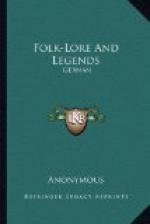and vanished.
EWEN OF THE LITTLE HEAD.
About three hundred years ago, Ewen Maclaine of Lochbuy, in the island of Mull, having been engaged in a quarrel with a neighbouring chief, a day was fixed for determining the affair by the sword. Lochbuy, before the day arrived, consulted a celebrated witch as to the result of the feud. The witch declared that if Lochbuy’s wife should on the morning of that day give him and his men food unasked, he would be victorious, but if not, the result would be the reverse. This was a disheartening response for the unhappy votary, his wife being a noted shrew.
The fatal morning arrived, and the hour for meeting the enemy approached, but there appeared no symptoms of refreshment for Lochbuy and his men. At length the unfortunate man was compelled to ask his wife to supply them with food. She set down before them curds, but without spoons. When the husband inquired how they were to eat them, she replied they should assume the bills of hens. The men ate the curds, as well as they could, with their hands; but Lochbuy himself ate none. After behaving with the greatest bravery in the bloody conflict which ensued, he fell covered with wounds, leaving his wife to the execration of the people. She is still known in that district under the appellation of Corr-dhu, or the Black Crane.
But the miseries brought on the luckless Lochbuy by his wife did not end with his life, for he died fasting, and his ghost is frequently seen to this day riding the very horse on which he was mounted when he was killed. It was a small, but very neat and active pony, dun or mouse-coloured, to which the Laird was much attached, and on which he had ridden for many years before his death. Its appearance is as accurately described in the island of Mull as any steed is at Newmarket. The prints of its shoes are discerned by connoisseurs, and the rattling of its curb is recognised in the darkest night. It is not particular with regard to roads, for it goes up hill and down dale with equal velocity. Its hard-fated rider still wears the same green cloak which covered him in his last battle; and he is particularly distinguished by the small size of his head, a peculiarity which, we suspect, the learned disciples of Spurzheim have never yet had the sagacity to discover as indicative of an extraordinary talent and incomparable perseverance in horsemanship.
It is now above three hundred years since Ewen-a-chin-vig (Anglice, Hugh of the Little Head) fell in the field of honour; but neither the vigour of the horse nor of the rider is yet diminished. His mournful duty has always been to attend the dying moments of every member of his own tribe, and to escort the departed spirit on its long and arduous journey. He has been seen in the remotest of the Hebrides; and he has found his way to Ireland on these occasions long before steam navigation was invented. About a century ago he took a fancy for a young man of his own race, and frequently did him the honour of placing him behind himself on horseback. He entered into conversation with him, and foretold many circumstances connected with the fate of his successors, which have undoubtedly since come to pass.




